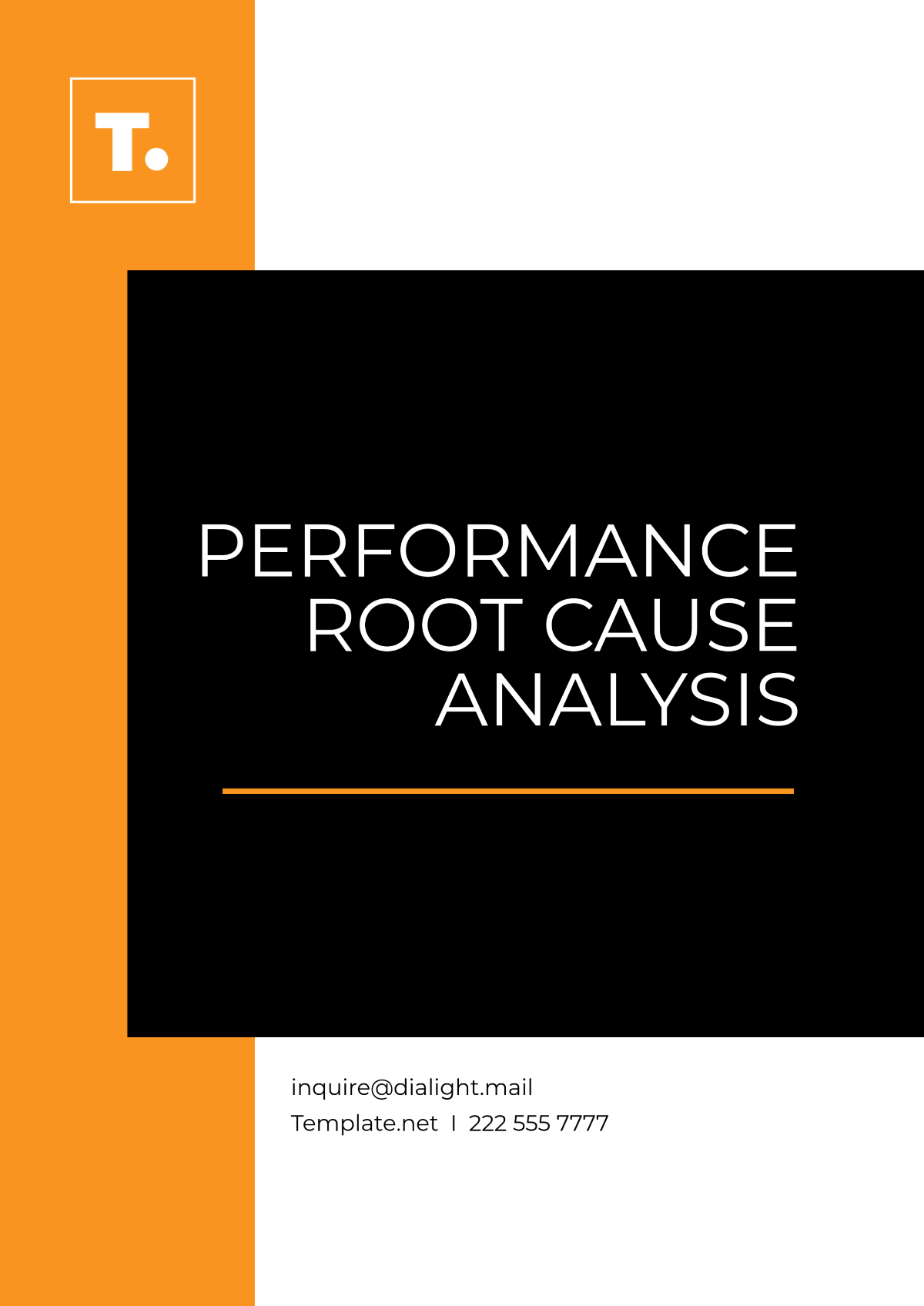Gym Root Cause Analysis
I. Introduction
A. Overview of Root Cause Analysis
Root Cause Analysis (RCA) is a systematic approach used to identify the underlying causes of problems or issues within an organization. At [Your Company Name] Gym, conducting an RCA is vital to uncovering the fundamental reasons behind operational challenges in our gym, allowing us to implement effective solutions that prevent recurrence.
B. Purpose of the Analysis
The primary purpose of this Root Cause Analysis is to investigate a significant issue affecting the operations at [Your Company Name] Gym. By identifying the root causes, we aim to develop and implement strategies that will enhance our gym's efficiency, member satisfaction, and overall performance.
C. Scope of the Analysis
This analysis will cover all aspects of the gym's operations, including equipment maintenance, member services, staff performance, and facility management. We will focus on the problem's impact on daily operations and long-term goals, ensuring a thorough examination and comprehensive solution.
II. Problem Identification
A. Description of the Issue
The issue at hand involves frequent equipment malfunctions, resulting in downtime and reduced availability for gym members. These malfunctions have led to a significant number of member complaints, decreased satisfaction, and potential loss of membership renewals. Understanding the extent of this issue requires a detailed examination of all related factors.
B. Impact on Gym Operations
The equipment malfunctions have severely impacted gym operations. Members experience delays and frustration, leading to a decline in gym attendance and engagement. Additionally, the increased maintenance costs strain the gym's budget, diverting funds from other essential areas.
C. Initial Observations and Evidence
Preliminary observations indicate that certain equipment models are prone to failure more frequently than others. Maintenance logs show recurring issues with specific machines, and staff interviews reveal concerns about inadequate training and insufficient preventative maintenance practices.
III. Data Collection
A. Methods of Data Collection
Effective data collection is crucial for identifying the root causes of the problem. At [Your Company Name], we will employ various methods to gather comprehensive data, ensuring a robust analysis.
METHOD | DETAILS |
Interviews | Conducting interviews with gym staff, maintenance personnel, and members provides qualitative insights into the issue. These interviews will help identify common patterns and specific incidents related to equipment malfunctions. |
Surveys | Distributing surveys to a larger group of gym members will capture quantitative data on their experiences and perceptions. This will help in understanding the broader impact of the equipment issues. |
Observation | Observing gym operations during peak and off-peak hours will provide direct evidence of how equipment malfunctions affect usage patterns and member behavior. |
Document Review | Reviewing maintenance records, incident reports, and equipment manuals will offer historical data and technical information crucial for identifying recurring problems and potential causes. |
B. Sources of Data
Staff Members: Insights from staff members, including trainers and front desk personnel, are valuable in understanding the operational challenges posed by equipment failures.
Gym Members: Feedback from gym members who directly experience the impact of equipment malfunctions is essential for assessing the problem's extent and member satisfaction.
Equipment Logs: Detailed logs of maintenance activities, repairs, and equipment usage will highlight patterns and identify machines with higher failure rates.
Maintenance Records: Historical maintenance records will provide information on past repairs, the frequency of issues, and the effectiveness of previous interventions.
IV. Data Analysis
A. Qualitative Analysis
Qualitative analysis involves examining non-numerical data to identify patterns and themes. By analyzing interview transcripts and survey responses, we can categorize issues and understand the underlying causes from multiple perspectives.
Identifying Patterns: Through qualitative analysis, we can identify recurring themes in member complaints and staff observations. For example, frequent mentions of specific equipment models can indicate a common source of problems.
Categorizing Issues: Grouping related issues together allows us to see broader trends. Issues related to maintenance practices, equipment quality, and member usage patterns can be categorized to provide a clearer picture of the root causes.
B. Quantitative Analysis
Quantitative analysis uses numerical data to uncover trends and measure the problem's extent. This involves statistical and trend analysis to support our findings with concrete evidence.
Statistical Analysis: Analyzing survey data and equipment logs statistically helps quantify the frequency and impact of equipment malfunctions. This analysis can reveal which machines fail most often and the typical duration of downtime.
Trend Analysis: Identifying trends over time provides insights into whether the problem is worsening or improving. Trend analysis can help correlate maintenance activities with equipment performance, highlighting effective or ineffective practices.
C. Tools and Techniques
Fishbone Diagram (Ishikawa): The Fishbone Diagram will help us systematically explore potential causes of equipment malfunctions, categorizing them into areas such as maintenance practices, equipment quality, and user behavior.
5 Whys Technique: By repeatedly asking "why" to each identified issue, the 5 Whys Technique helps drill down to the root cause of problems. This method ensures a thorough exploration of each contributing factor.
Pareto Analysis: Using the Pareto Principle, we can identify the few causes that contribute to the majority of problems. This analysis will help prioritize solutions by focusing on the most significant issues.
V. Root Cause Identification
A. Analysis of Findings
The analysis of collected data will provide a comprehensive understanding of the underlying causes of equipment malfunctions. We will review all qualitative and quantitative data to identify consistent patterns and correlations.
B. Verification of Root Causes
To ensure the accuracy of identified root causes, we will cross-check findings from different data sources. For example, if maintenance logs and member feedback both highlight a specific machine model as problematic, we can confirm it as a root cause.
C. Prioritization of Root Causes
Not all identified causes will have the same impact on operations. By prioritizing root causes based on their severity and frequency, we can focus our efforts on addressing the most critical issues first. This prioritization will guide the development of effective solutions.
VI. Solution Development
A. Brainstorming Potential Solutions
With the root causes identified, the next step is to brainstorm potential solutions. Involving key stakeholders, including maintenance staff, trainers, and management, ensures diverse perspectives and innovative ideas.
B. Evaluating Solution Options
Each proposed solution will be evaluated based on criteria such as feasibility, cost, impact on operations, and member satisfaction. This evaluation process ensures that we select solutions that are practical and effective.
C. Selecting the Best Solutions
The best solutions will be those that address the root causes most effectively while being implementable within the gym's resources and constraints. These solutions will form the basis of our implementation plan.
VII. Implementation Plan
A. Action Steps
The implementation plan will outline specific action steps required to address the identified root causes. Each step will be detailed, ensuring clarity and accountability.
B. Responsible Parties
Assigning responsibility for each action step ensures that tasks are completed efficiently. This section will specify who is responsible for implementing each solution, whether it be maintenance staff, management, or external contractors.
C. Timeline for Implementation
A clear timeline will be established to guide the implementation process. This timeline will include milestones and deadlines to ensure timely progress and completion of each action step.
D. Required Resources
Identifying the resources needed for implementation, such as tools, equipment, and personnel, ensures that all necessary components are available. This section will also include a budget to cover any associated costs.
E. Risk Assessment and Mitigation
Potential risks associated with implementing the solutions will be assessed, and mitigation strategies will be developed. This ensures that any challenges encountered during implementation can be effectively managed.
VIII. Monitoring and Evaluation
A. Monitoring Plan
A monitoring plan will be established to track the progress of the implementation and the effectiveness of the solutions. Regular check-ins and updates will ensure that the plan stays on track.
B. Evaluation Criteria
Criteria for evaluating the success of the implemented solutions will be defined. These criteria will measure improvements in equipment performance, member satisfaction, and overall gym operations.
C. Feedback Mechanisms
Feedback mechanisms will be put in place to gather input from staff and members during and after implementation. This feedback will help identify any issues that need to be addressed and ensure continuous improvement.
D. Continuous Improvement
The process of continuous improvement will involve regularly reviewing and refining the implemented solutions. This ensures that the gym remains proactive in addressing any future challenges and maintaining high operational standards.
IX. Conclusion
A. Summary of Findings
The Root Cause Analysis has provided a detailed understanding of the underlying causes of equipment malfunctions at [Your Company Name] Gym. Through comprehensive data collection and analysis, we have identified key issues that need to be addressed.
B. Summary of Solutions and Implementation Plan
The proposed solutions, developed through collaborative brainstorming and rigorous evaluation, address the root causes effectively. The implementation plan outlines clear action steps, responsibilities, and timelines to ensure successful execution.
C. Expected Outcomes
By implementing these solutions, we expect to see a significant reduction in equipment malfunctions, improved member satisfaction, and enhanced gym operations. The gym will benefit from increased efficiency, lower maintenance costs, and higher member retention.
D. Next Steps
The next steps involve executing the implementation plan, monitoring progress, and evaluating the outcomes. Continuous improvement efforts will ensure that [Your Company Name] Gym remains a top choice for fitness enthusiasts by providing reliable equipment and exceptional service.

















































